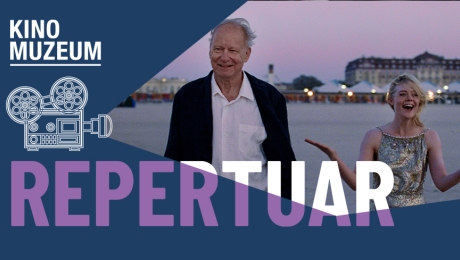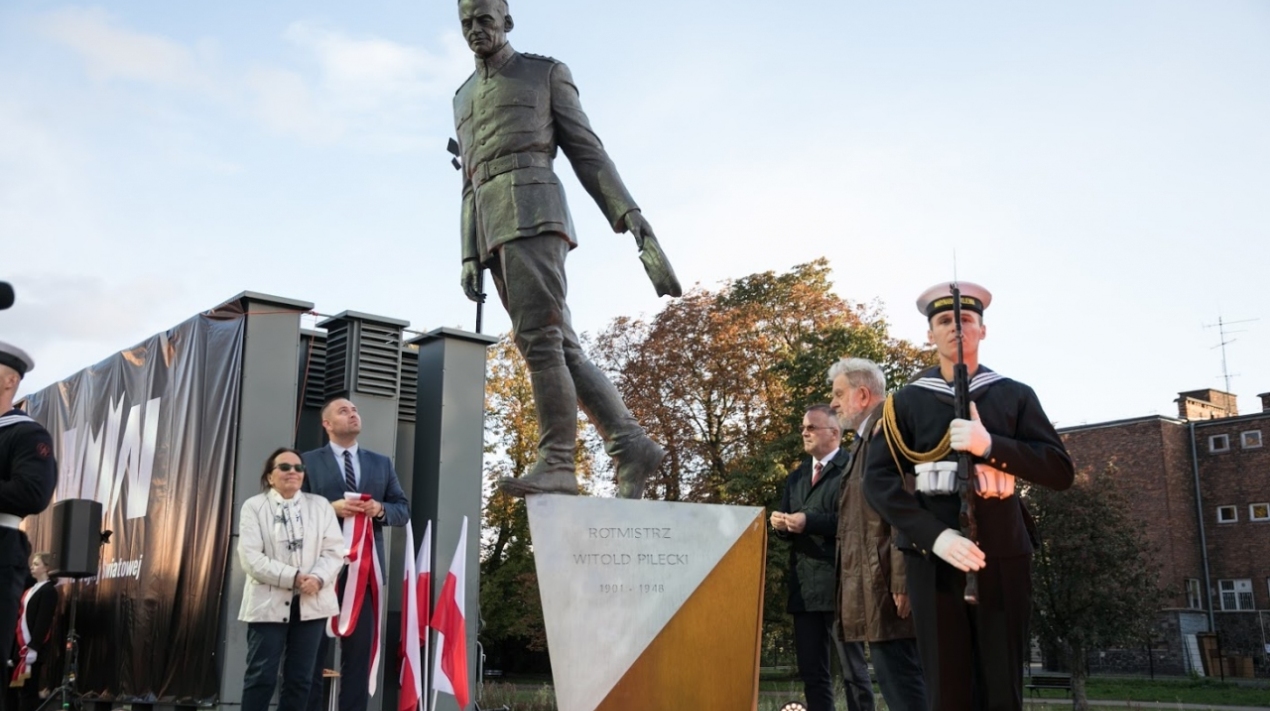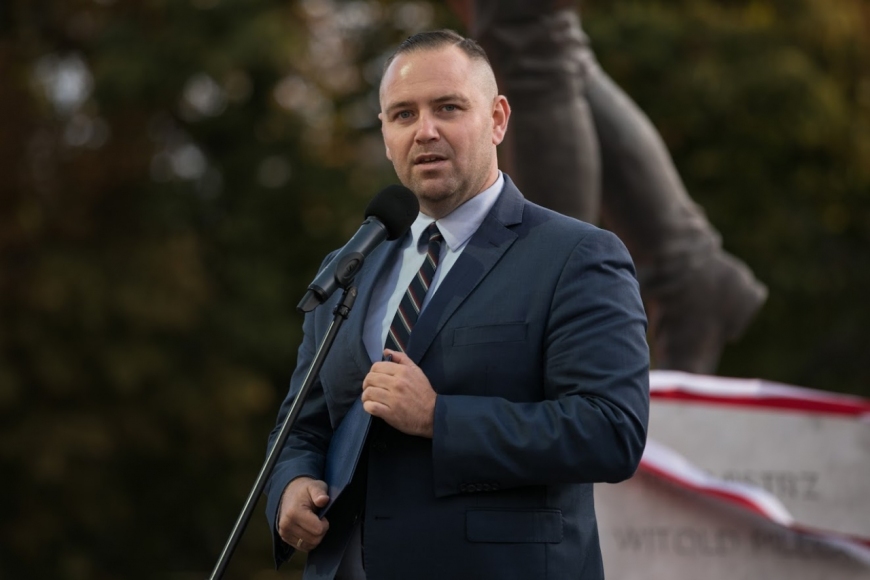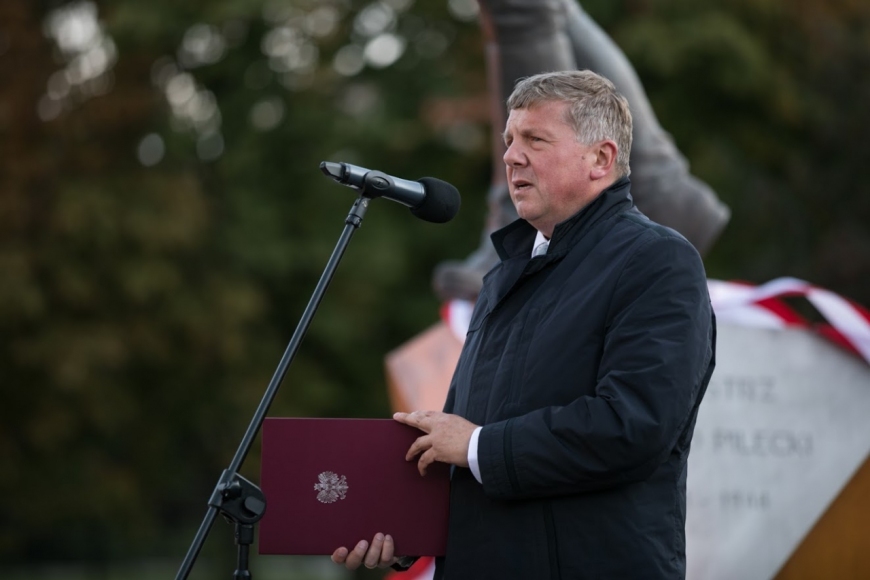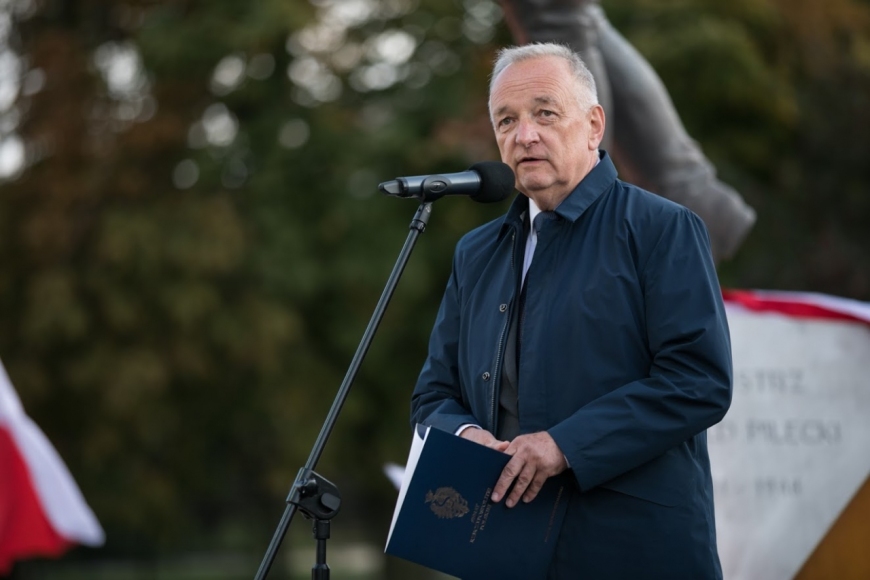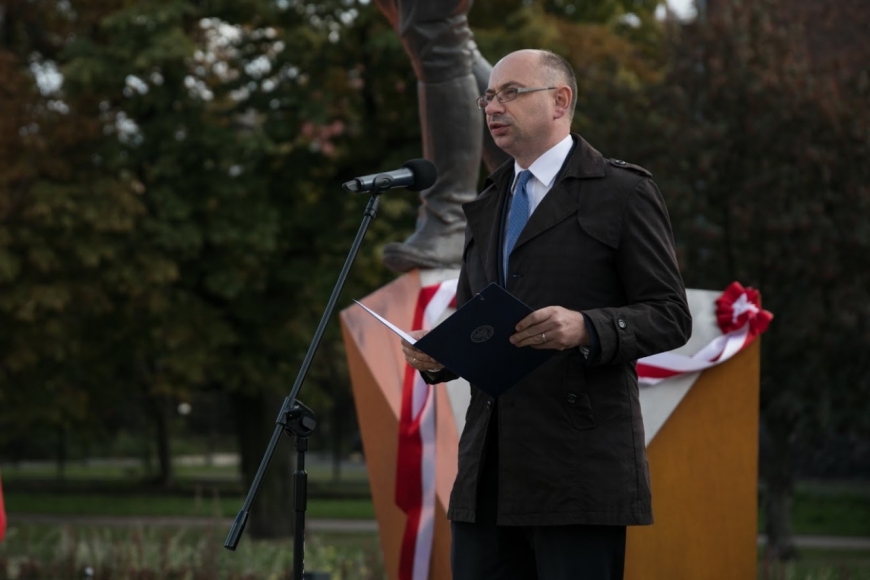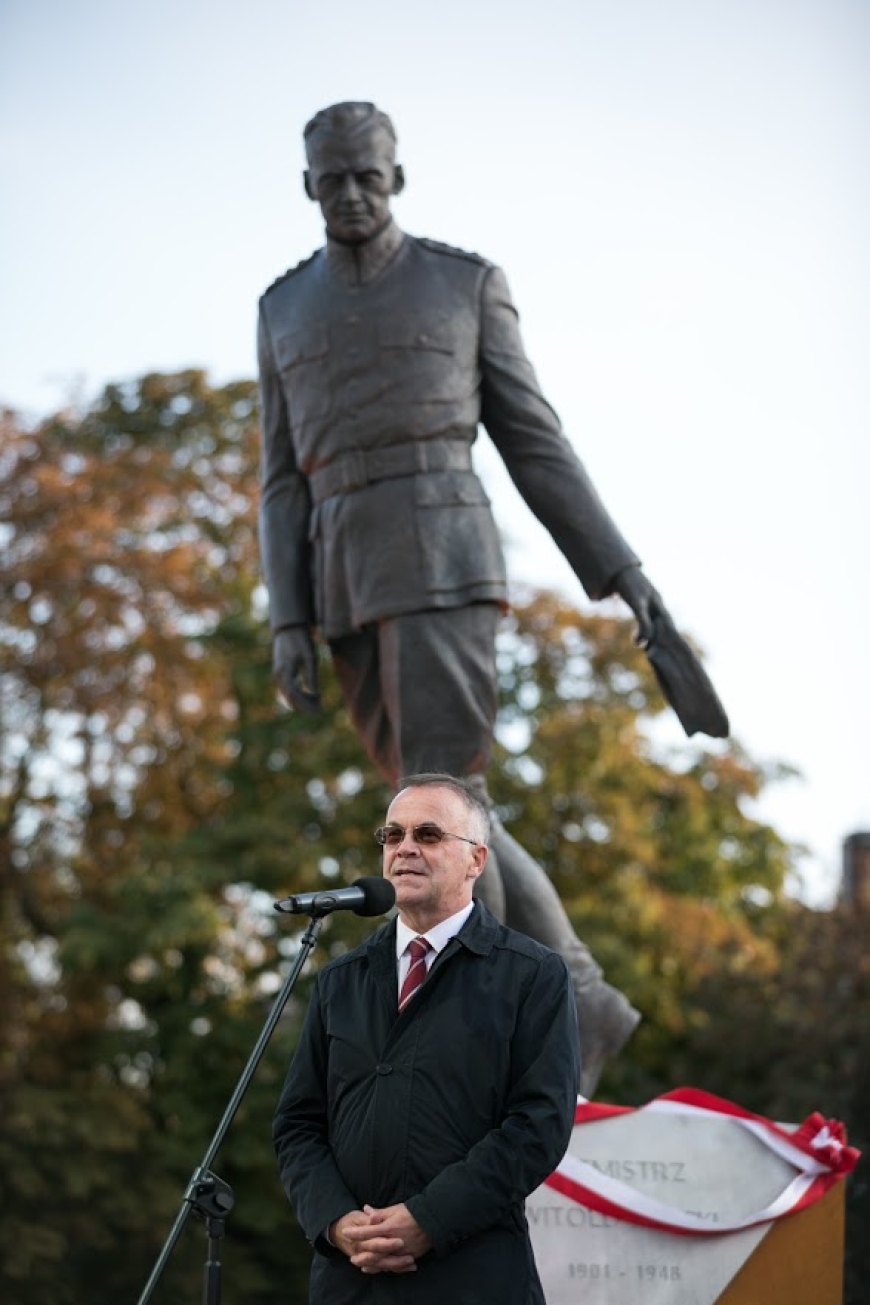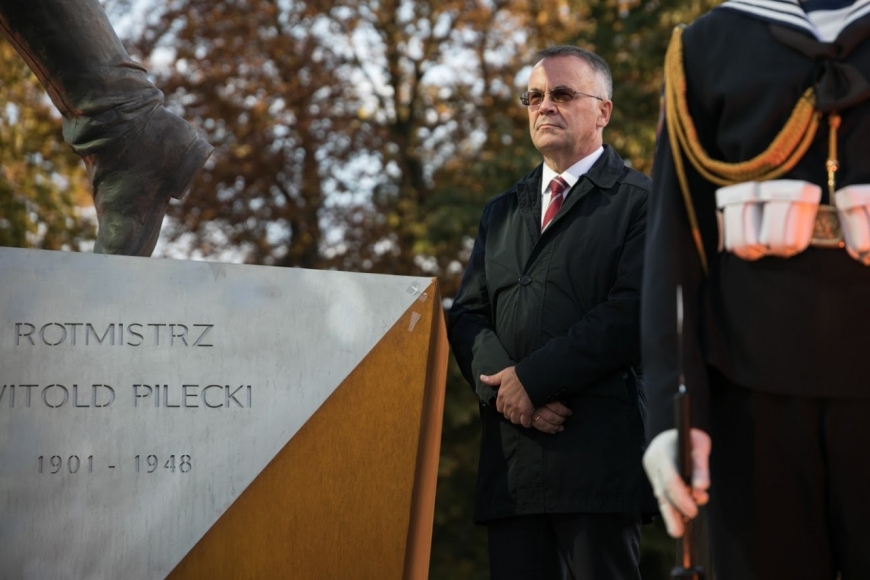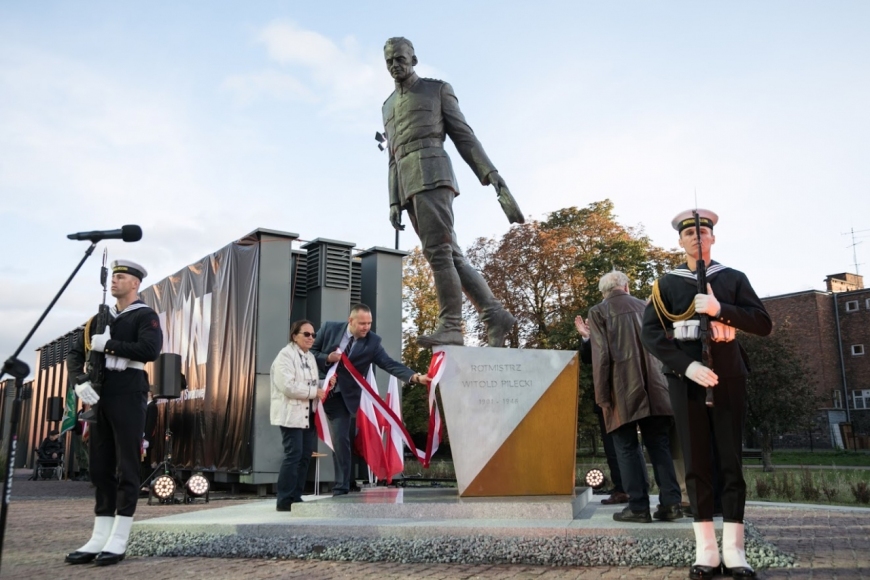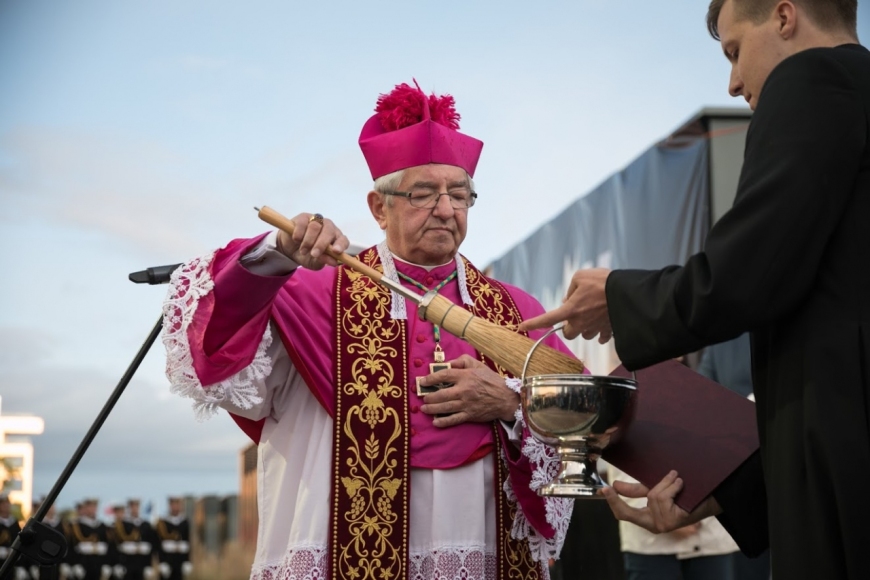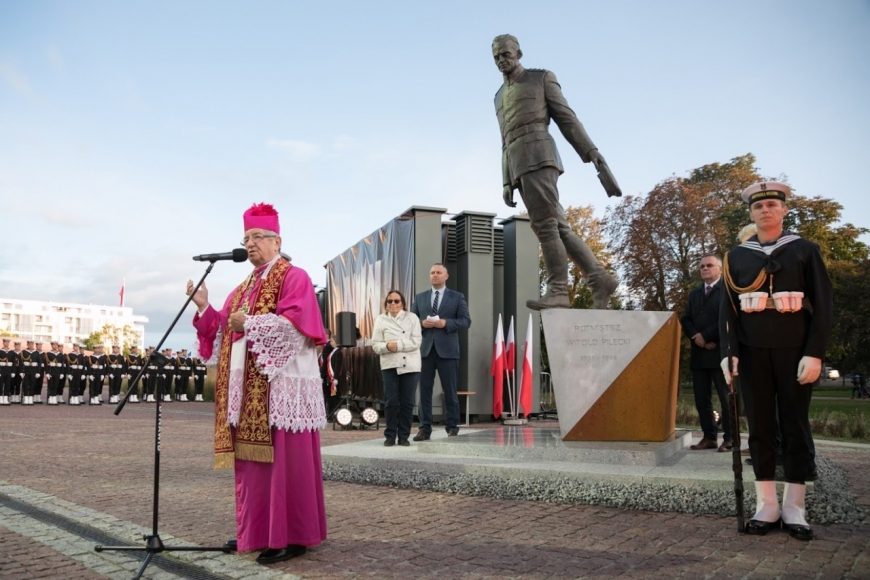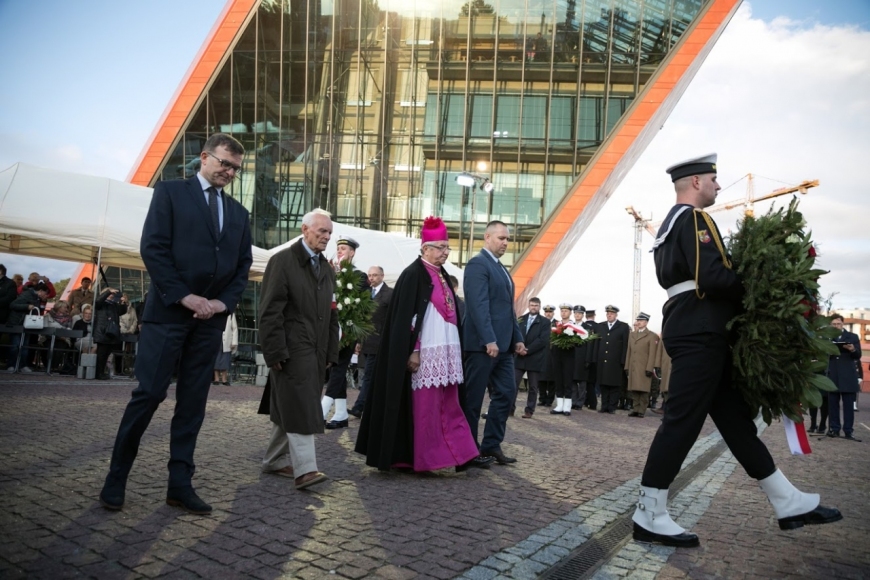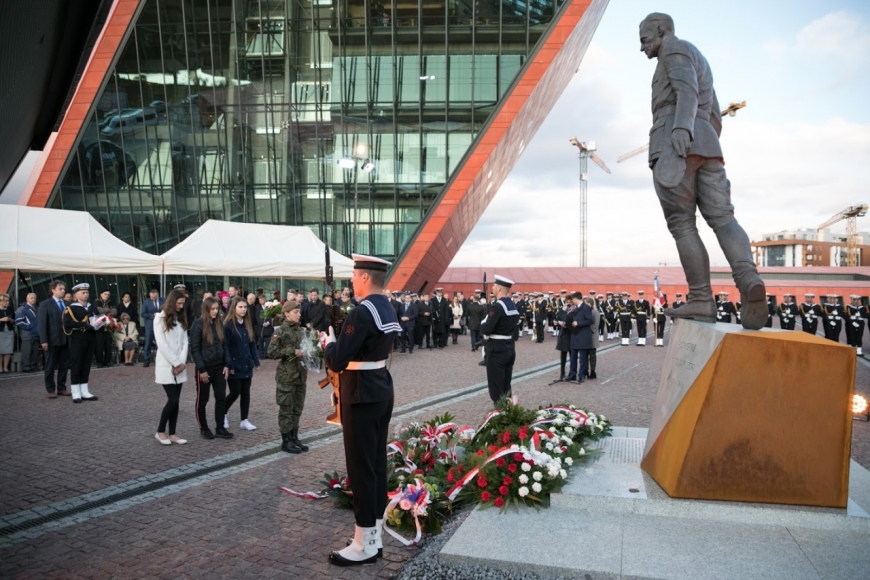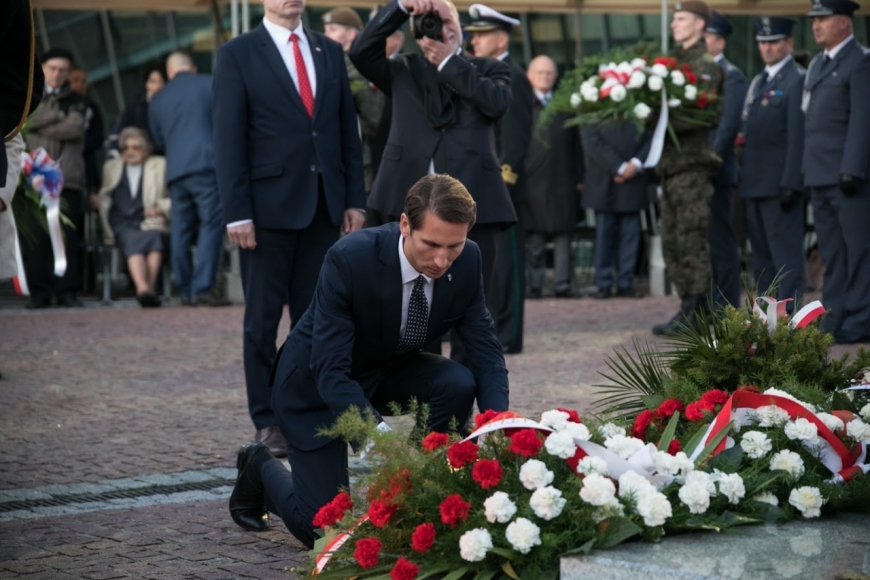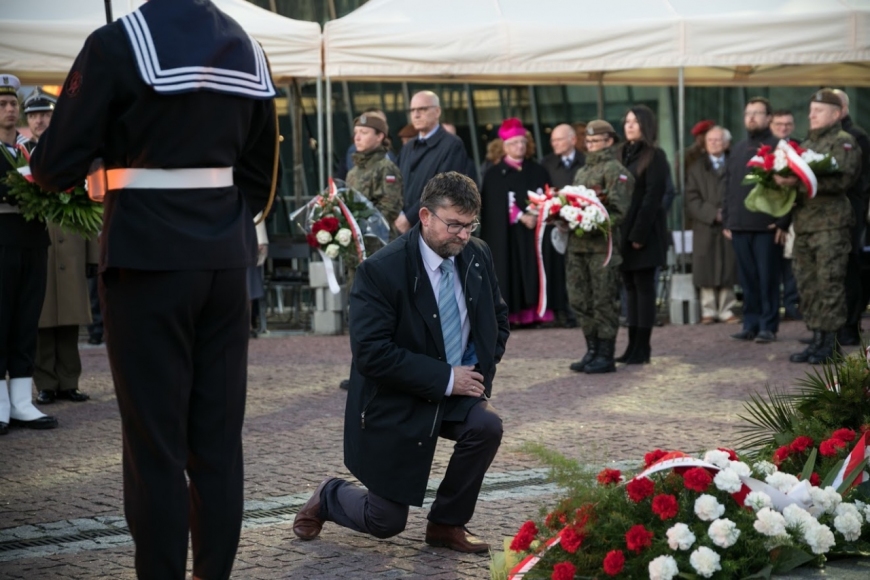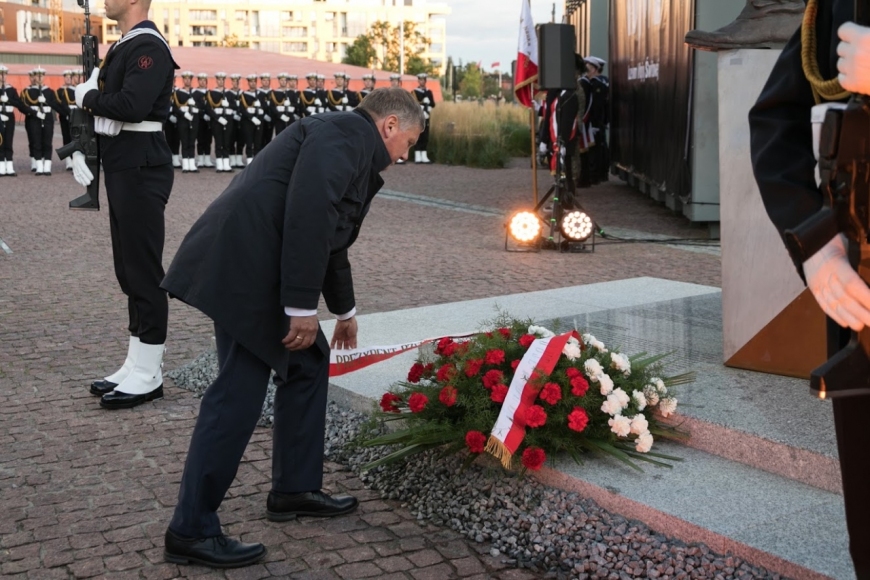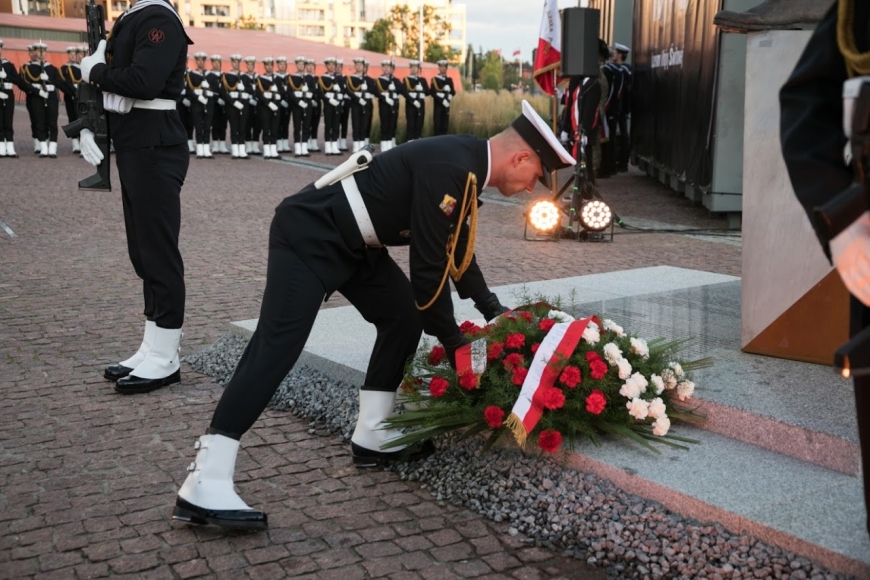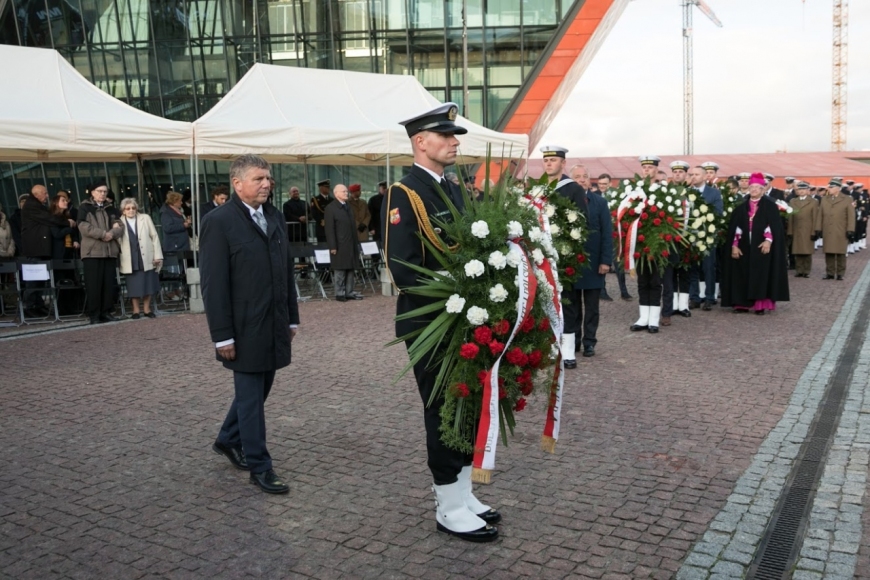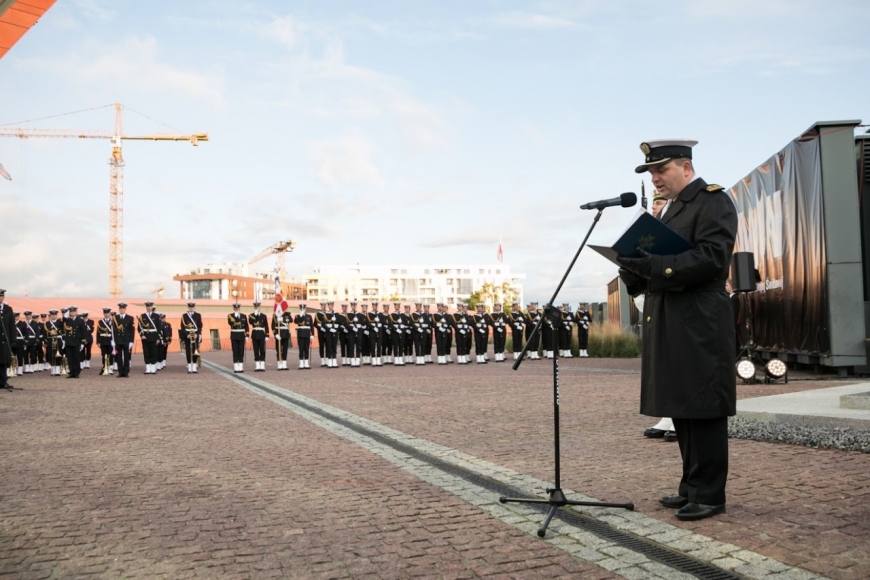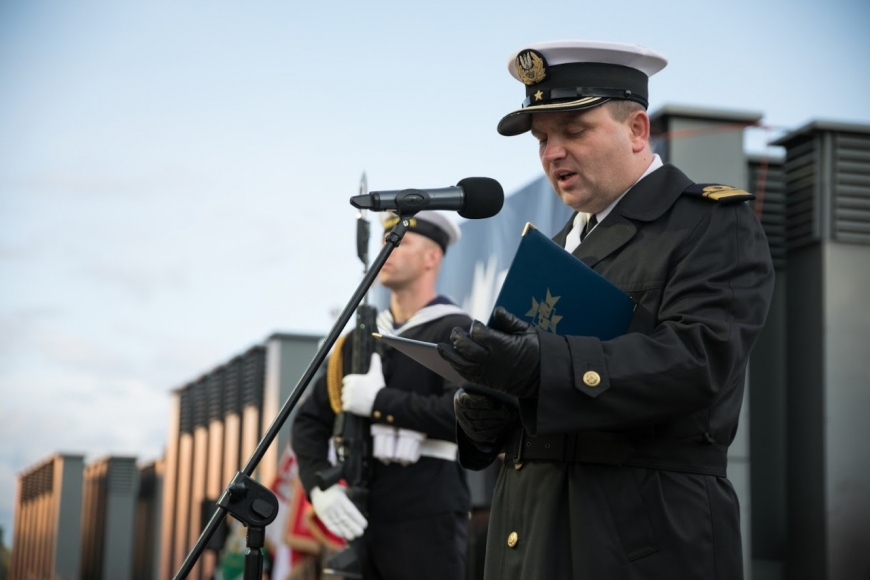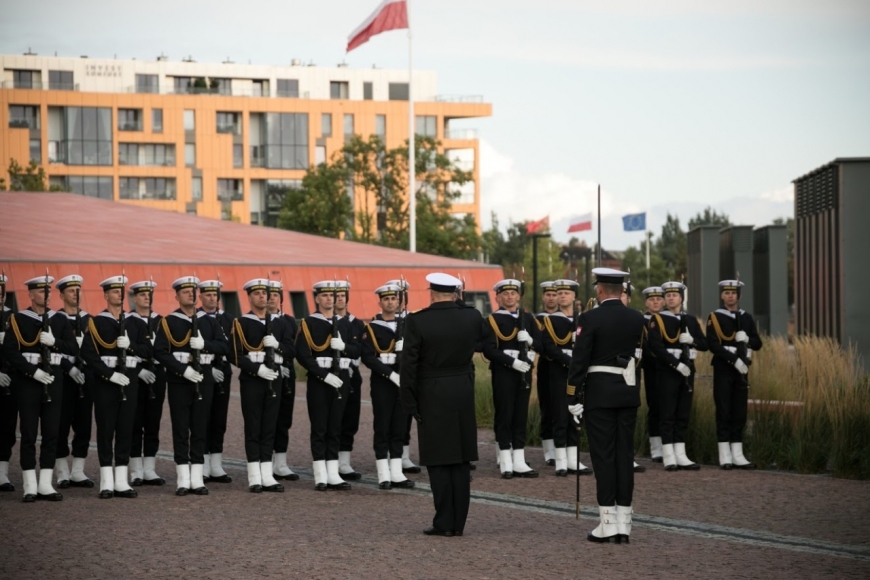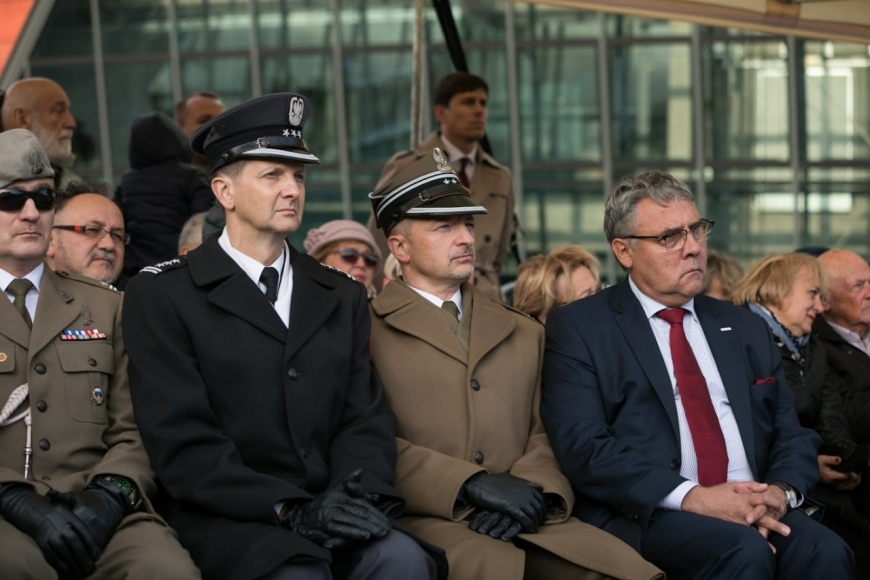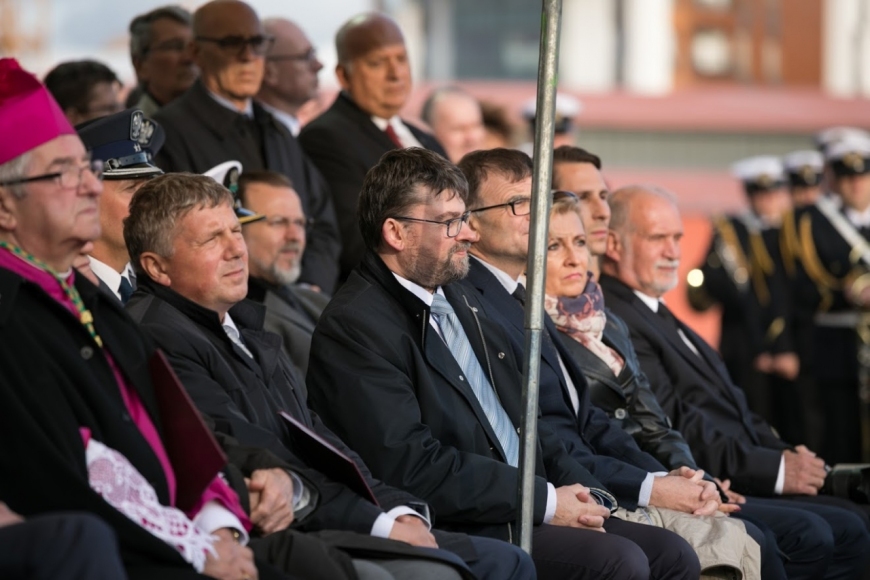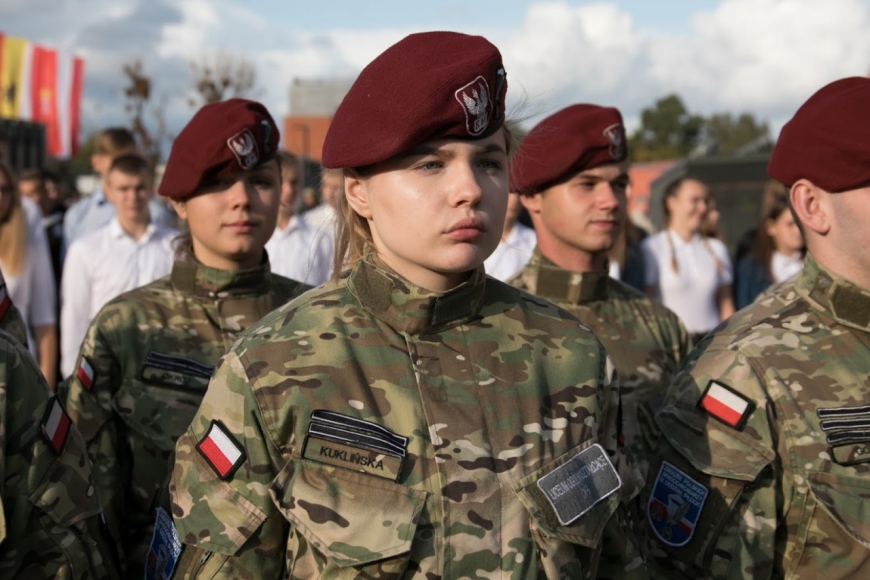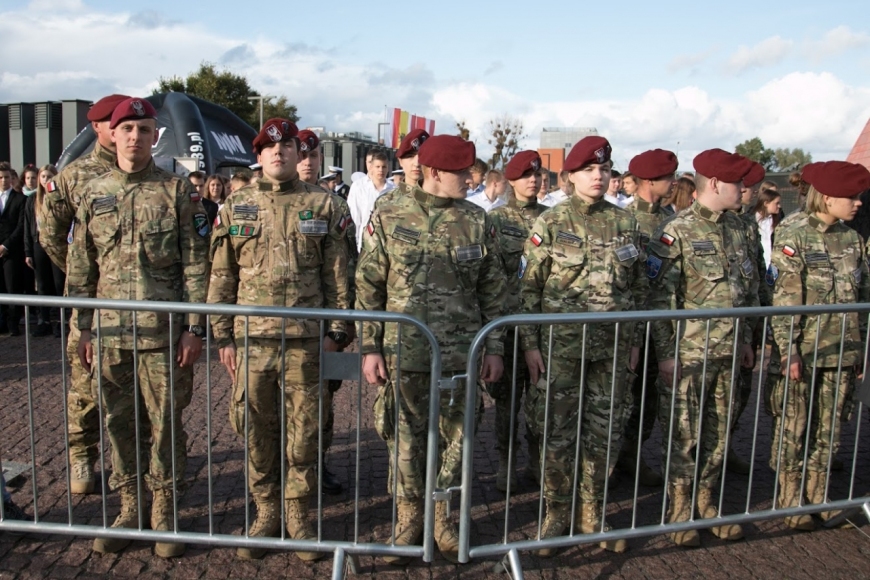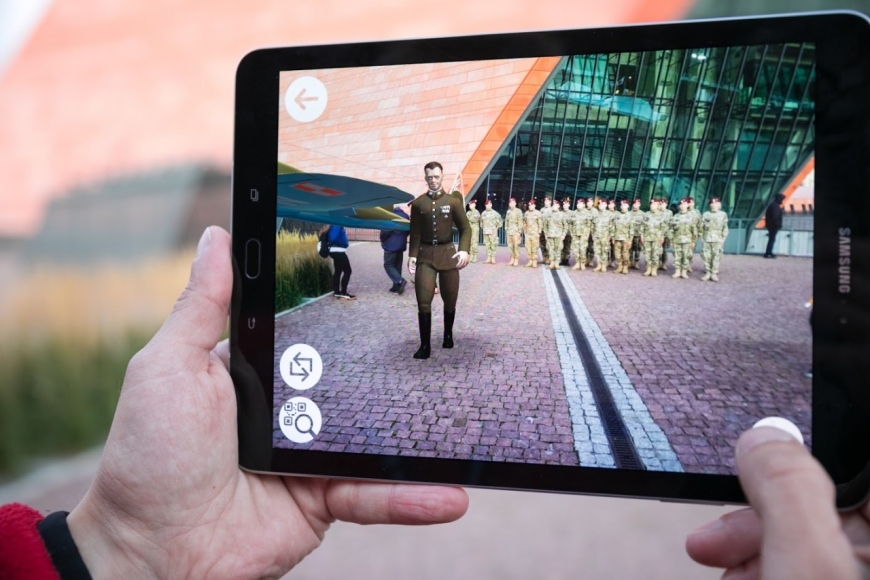Ceremony of unveiling the Statue of Cavalry Captain Witold Pilecki
The ceremony of unveiling the statue of Cavalry Captain Witold Pilecki took place on 17 September 2019, on the 80th anniversary of the Soviet invasion of Poland, in the square in front of the Museum of the Second World War in Gdańsk.
The Museum honoured a truly unique figure in history. Man of many talents, deeply spiritual. Scout, social activist, landlord and artist, officer of the Polish Army and conspirator.
Design of the statue was selected after a call for proposals. The winning idea selected by the Jury headed by Professor Stanisław Radwański was presented by Maciej Jagodziński–Jagenmeer Sculpture Studio.
The monument depicts the figure of Cavalry Captain on the pedestal, whose shape refers to the Museum’s architectural forms. The 2.8-metre-high bronze statue captures the movement reflecting, in a symbolic way, the Captain’s voluntary imprisonment in the German concentration camp, Auschwitz and his daring flight - Witold Pilecki, presented in the captain uniform, with a hand gesture throws the camp cap behind him. Placing the statute on the edge of the pedestal symbolises a characteristic feature of Captain’s biography: for most of his life he was caught between life and death, between two totalitarianisms, between independence and occupation of Poland.
The ceremony was attended by the heroes who had fought for Free Poland: Mrs. Wanda Bortkiewicz née Czyżewska pseudonym “Basia”, liaison officer and nurse of Major Zygmunt Szendzielarz “Łupaszko”, who came with her brother, priest Antoni Czyżewski, professor Jerzy Grzywacz pseudonym “Tapir”, Gray Ranks scout, participant of the Warsaw Uprising, Joanna and Andrzej Gwiazda, Secretary of State in the Ministry of Culture and National Heritage Jarosław Sellin, Gdańsk Metropolitan Archbishop Sławoj Leszek Głódź, Senator of the Republic of Poland Antoni Szymański representing the Marshal of the Senate of the Republic of Poland Stanisław Karczewski, Piotr Karczewski, social advisor to the President of Poland Andrzej Duda, Mateusz Szpytma, PhD, Deputy President of the Institute of National Remembrance, heads and representatives of uniformed services, MPs, town councillors, representatives of the Pomeranian Voivodeship self-government, combatants, members of the Jury of the call for proposals and of the Honorary Committee for the construction of the statue of Captain Witold Pilecki, artist-sculptor Maciej Jagodziński-Jagenmeer, co-author of the statue.
Particularly warm welcome was given to the representatives of Combatant Associations and their families: Ms. Emilia Maćkowiak, President of the Board of the Katyń Family Association in Gdańsk and Ms. Maria Wieloch, President of the Ponary Family Association, Mr. Andrzej Osipów, representative of the Association “Godność” [Dignity] and Ms. Małgorzata Kupiszewska, representative of the Foundation “Gdzie” [Where].
The idea to honour Cavalry Captain with a statue erected next to the Museum accompanied its functioning for over two years. It was set forth and declared by Karol Nawrocki, PhD, the Museum’s host, who addressed the participants of the ceremony as follows:
“I dream that in the times of our fall, the times when we need reinforcement, Cavalry Captain will become our value compass. A compass showing us the right direction. Dignity, honour, nobleness, freedom, but also love - love for another human being, family, God and Motherland - these are the values represented by this hero. He’s a hero of not only great things, national breakthroughs, but also of everyday life. He’s a hero who did not need war and death to serve the Republic of Poland. He served Poland with his social involvement, for which he was honoured with the Silver Cross of Merit in 1938. Even when he was choosing Motherland and was thus forced to choose war too for this Motherland, he didn’t forget that family was the single most important thing for him, which we are also reminded by the memoirs of Ms. Zofia Optułowicz-Pilecka”.
Then, Karol Nawrocki, PhD, the Director of the Museum, read the message of Ms. Zofia Pilecka-Optułowicz - the daughter of Captain Witold Pilecki in Gdańsk:
“The first word I should say in Gdańsk is ‘Thank you!’. I thank all the people of goodwill who commemorate my Father in the city, which is so important for the Poles. (...) I’m asking politicians, journalists, commentators: I’m asking all of you to accept this statue without refined disputes. So that we could recognise it as our common, Polish piece. For us, the family, monument splendours and honours do not matter. We want every Pole and every man of goodwill to see in this statue young Witold Pilecki, still a second lieutenant, who on his first day in Auschwitz upon seeing in the evening lights wild figures of the torturers and the blows inflicted on the newly arrived prisoners, tells himself and then notes down in his Report: ‘I felt joy...’. He felt joy in such a wild place and in such circumstances?! Yes, because he realised that what he did was right, that he would be greatly needed there!
Let all of us - bearing these words in mind - feel joy of doing good for another human being. Even if it exposes us to sneers and misunderstanding of our intentions. Let’s accept this statue with a pure heart, as a statue of joy of doing good and a statue of faithfulness to Poland”.
List of the President of the Republic of Poland Andrzej Duda was read by Piotr Karczewski, social advisor of the President Of The Republic Of Poland:
“I’m extremely happy that thanks to the new commemoration, the numerous guests visiting the institution, particularly those coming from abroad, will now have a chance to know better and honour one of the most prominent European heroes of the fight for freedom against two totalitarianisms: German Nazism and Soviet communism. I believe it is very important and valuable that the knowledge of the recent history of Poland and Poles could be popularised in Western countries through the fate of this wonderful figure. Therefore, I would like to thank with whole my heart the initiators and all those, who enabled the construction of this statue. (...) After having committed a court crime against Captain Pilecki, the communist regime did its best to wipe out also the memory of him. However, they did not succeed and I believe that just as his legend survived despite being doomed to oblivion and 40 years of silence, so will there be found his remains, which were secretly buried by his torturers. Without a doubt, Witold Pilecki will forever be one of the most heroic persons in the pantheon of Polish heroes. Lest we forget!”.
Senator Antoni Szymański read a letter by Marshal of the Senate of the Republic of Poland Stanisław Karczewski:
“’Love your Motherland. Love your sacred faith and tradition of your Nation. Grow to be men of honour, always true to your highest values, which you must serve with your whole life’ - this was the motto of our today hero, who filled his life with exactly this content. (...) His extremely devoted and dangerous life may be a source of inspiration and a model of patriotism for people today, and particularly for the young generation. We all owe Captain Pilecki as he proved steadfast. (...) Today ceremony is another, important element of commemorating this exceptional person. He has his rightful place in the Poles’ national memory, and now he also has a real monument in Gdańsk”.
Then, Secretary of State in the Ministry of Culture and National Heritage, Jarosław Sellin, took the floor:
“Witold Pilecki is a symbol depicting Polish fate in the first half of the 20th century. Take a look at the dates of his birth and death: it is exactly the first half of the 20th century with all its dramatic moments the Poles had to survive - with the most tragic war of our times, which Witold Pilecki fought for 9, not 6, years. That’s why the Ministry of Culture and National Heritage established the Witold Pilecki Center for Totalitarian Studies - because the Captain was the most symbolic figure struggling with both totalitarianisms - already since 1920 and throughout the entire 9-year-long fight starting in 1939 until his death”.
Then, Mateusz Szpytma, PhD, Deputy President of the Institute of National Remembrance, took the floor:
“The day of this ceremony is also significant. Today, we commemorate the third tragic date of 1939. After the 23 August and Stalin-Hitler pact, after 1 September when Nazi Germany invaded Poland, there came 17 September, when the Soviets attacked Poland, which was fighting with Hitler’s army. Captain Pilecki devoted his life to the fight with the German occupier and was murdered by the other occupier - the one who occupied over half of our country exactly 80 years ago, on 17 September. There’s hardly a more symbolic date to honour Captain Pilecki in a place, whose aim is to spread knowledge of the tragedy of WWII and to commemorate its victims and heroes”.
Cavalry Captain Witold Pilecki’s statue was officially unveiled by, inter alia, Jarosław Sellin, Director Karol Nawrocki, Professor Jerzy Grzywacz, Mrs. and Mr. Joanna and Andrzej Gwiazda, while Gdańsk Metropolitan Archbishop Sławoj Leszek Głódź consecrated the unveiled statue.
Then, the guests were invited to use a new application, which was launched during the ceremony - the app had been created especially for the visitors of the Museum of the Second World War in Gdańsk using augmented reality technology, which allows to tell history in a modern language of virtual media. Thanks to the app, the visitors could see the Captain walking around the square next to his new statue or take a look at Polish planes from 1939.









